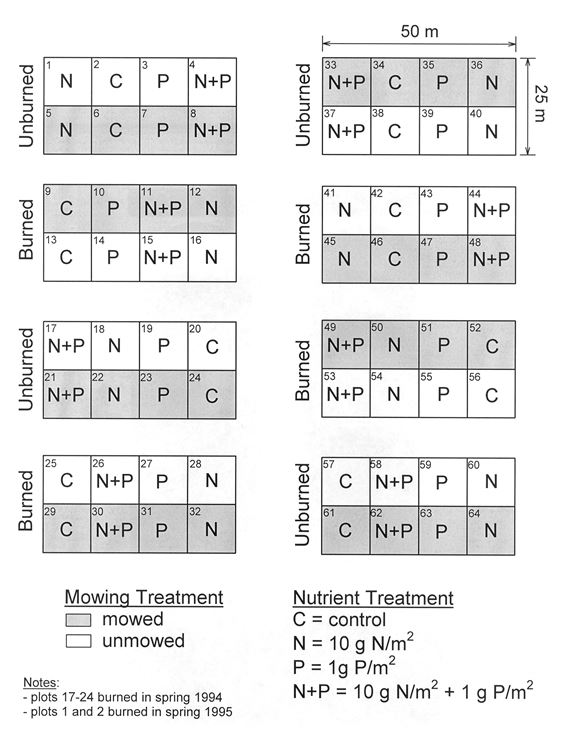Location of Sampling Stations: HQC.
Frequency of Sampling: Once per year for peak biomass in September to October.
Variables Measured: 1. Plant biomass sorted by grass, forb, woody and p.dead. (PBB011); 2. Total-N and total-P (PBB012)
Methods: Field and lab methods are identical to those for PAB01 except two 0.1m2 quadrats are clipped from each plot. The plant material is dried at 60oC and then separated into grass, forb, woody and p.dead material. The samples are then dried again at 60oC and weighed. Samples are no longer kept for analysis.
Summary of All Changes:
Prior to 1992: only one 0.1m2 quadrat per plot was clipped.
As of 2000: all samples are discarded. Prior to this, all samples were kept and ground to pass a 2 mm screen and acid digested by the Kjedahl procedure and the solution analyzed for total-N and total-P by automated calorimetric analysis. (PBB012)
2002: c.dead no longer separated from live grass.
Before 2004: there was a mowing treatment for half of the plots. Mowed plots were clipped in mid- to late - June before mowing; then mowed to a height of 4 inches. All clippings were removed. The mowed plots were clipped again at time of peak biomass; same date as un-mowed.
June 2004: irrigation cistern collapsed during repairs (located uphill from plots 33-44). Huge flood and rock debris; debris was removed within 2 days of 'damage'.
May 2, 2006: damage to middle section of plot #44 and a small part on east side of #43. There was a bentonite spill during the installation of two seismograph wells on the hill above these plots. An attempt was made to clean up the area. Damaged area was delineated by flags and avoided during clipping for 2 years.
2017: fertilizer treatments have ended.
For additional metadata information see: http://lter.konza.ksu.edu/sites/default/files/DC.pdf
For additional methods information see: http://lter.konza.ksu.edu/sites/default/files/MM.pdf